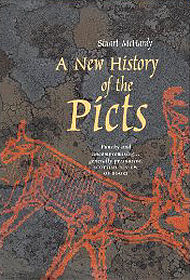 |
"A New History of the Picts" by Stuart McHardy sets out to shed new light on the story of the Picts. The Picts are usually portrayed as residing in one of the most mysterious corners of the early history of what is now known as Scotland: arriving and departing in uncertain circumstances and leaving little but a marvellous collection of carved stones to show they were ever here at all.
McHardy's thesis is a radical one, yet at the same time a very straightforward one. For him the Picts were the descendents of the indigenous peoples who occupied most of Scotland north of the Clyde-Forth line (apart from much of Argyll). The people who carved the Pictish symbol stones were simply the descendents of the people who had built the iron age brochs, who in turn were descendents of those who left their mark on the landscape in the bronze age and neolithic eras.
At the other end of the chronology he argues that the Picts were not somehow displaced or defeated by the Scots of what is now Argyll. Rather he believes that the Picts and Scots had an increasingly close coexistence over the centuries, to the point where they shared generations of kings to jointly form a nation that became known as "Alba". On this reading, the Picts are usually assumed to have disappeared simply because the English later chose to translate Alba as "Scotland", and so its inhabitants became known as "Scots". McHardy argues that it is possible to trace a continuity of tribal society from prehistory through the Picts and the Scots to the way of life of the highland clans which was only finally extinguished in the aftermath of the Battle of Culloden in 1746.
Anyone seeking to tell the early story of Scotland suffers from a series of problems. Primary references are few and very far between, and most were written centuries later and/or in England and Ireland. The source material has been trawled through time and again, and differences of interpretation tend to depend on fine difference of the reading of the primary sources, or differences in the degree to which an individual author is prepared to take folklore or common sense into account in painting his or her picture. At times Stuart McHardy appears to be working some of the well known references quite hard: but the story he tells is compelling one which gets over "the problem of the Picts" in a very satisfying way that builds the people who carved the Pictish symbol stones back into the mainstream of our ancestry.
InformationPaperback: 191 pagesLuath Press Ltd www.luath.co.uk 11 March 2011 ISBN-10: 1906817707 ISBN-13: 978-1906817701 Size: 23.2 x 15.6 x 1.6 cm Buy from Amazon (paid link) Visit Bookshop Main Page |
